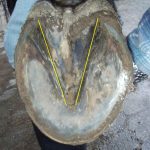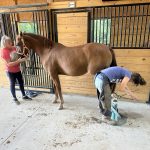Hoof care is arguably one of the most crucial elements in maintaining a healthy and active horse. A horse’s hooves are the foundation of its body, supporting its weight and enabling it to move freely and safely. Taking care of a horse’s hooves is a vital task for any owner, rider, or caretaker to ensure that the horse remains sound, comfortable, and ready to perform.
Horses rely on their hooves daily, whether they’re galloping on open fields, competing in sporting events, or simply enjoying a stroll. Understanding hoof anatomy, regular care practices, and common hoof problems will help you take proactive steps to keep your horse’s hooves in top condition. Truly, without healthy hooves, a horse cannot survive.
Understanding Horse Hoof Anatomy
Before diving into the care practices, it’s essential to understand the basic structure of a horse’s hoof. The hoof is a highly complex and specialized structure made up of several parts that work together to protect the horse’s foot, absorb shock, and maintain balance.
- Hoof Wall: The most visible and recognizable part of the hoof, the hoof wall is made of keratin, similar to human nails. It is strong and durable, offering protection for the inner structures of the foot.
-

Frog Frog: The frog is the triangular, soft tissue located at the bottom of the hoof. It acts as a natural shock absorber, helping distribute weight and cushioning the impact when the hoof strikes the ground. The frog also helps with traction, allowing the horse to maintain better balance on slippery surfaces.
- Sole: The sole is the bottom part of the hoof that contacts the ground, supporting the horse’s weight. It is concave in shape to prevent rocks and debris from getting lodged in the hoof. The sole is also involved in providing protection to the inner structures of the foot.
- Bulb of the Heel: The bulb is the rounded area at the back of the hoof above the frog. It plays an important role in shock absorption and is sensitive to pressure, so proper hoof care is essential to avoid pain and injury in this area.
- Coronary Band: The coronary band is the area where the hoof meets the skin at the top of the hoof. It is responsible for producing new cells that form the growth of the hoof wall. Any injury or irritation to this area can affect the health and growth of the hoof.
The Importance of Regular Hoof Care
Maintaining your horse’s hooves is crucial not only for their health but also for their overall well-being. Proper hoof care involves a combination of trimming, cleaning, moisturizing, and inspecting the hooves regularly. Here’s a breakdown of what each component of hoof care entails:
- Trimming and Shaping: Horses’ hooves grow continuously, much like human nails. If left untrimmed, hooves can become misshapen, cracked, or uncomfortable, leading to lameness or injury. Regular trimming is essential to maintaining a proper hoof shape and length.
- Fun Fact: The average horse’s hooves grow about ¼ to ½ inch per month, although growth rates can vary based on nutrition, activity, and environmental conditions.
 Most horses need to be trimmed every 6 to 8 weeks, depending on their activity level and how quickly their hooves grow. A skilled farrier is needed for this job, as they understand how to trim the hooves without causing harm or discomfort. To become a skilled farrier takes years of practice and training.
Most horses need to be trimmed every 6 to 8 weeks, depending on their activity level and how quickly their hooves grow. A skilled farrier is needed for this job, as they understand how to trim the hooves without causing harm or discomfort. To become a skilled farrier takes years of practice and training.Fun Fact: The process of trimming a horse’s hooves is ancient! Some of the earliest evidence of hoof care dates back to the ancient Romans, who used metal horseshoes to protect horses’ feet from rough terrain.
- Shoeing: Some horses, especially those used for high-performance activities like racing or heavy work, may require horseshoes. Horseshoes provide additional protection to the hoof, especially when horses are working on hard, rocky, or paved surfaces. At Layla Rose Ranch, we believe in keeping horses barefoot. So we do not shoe any of our rescues.
- Fun Fact: Horseshoes have been used for over 2,000 years, with the practice originating in ancient civilizations like the Greeks and Romans. The earliest horseshoes were made of bronze or iron, while modern horseshoes are typically crafted from steel.
Horseshoes are custom-fitted to each individual horse and can be nailed or glued onto the hoof. Not all horses need shoes, though. Horses that spend a lot of time in soft, grassy areas may not need shoes if their hooves are in good condition.
- Cleaning the Hooves: Regular hoof cleaning is one of the simplest and most important parts of hoof care. Using a hoof pick, you should clean out the hooves to remove dirt, debris, and manure that could cause infections like thrush.
- Fun Fact: Horses’ hooves are incredibly strong but also delicate in certain areas. If debris gets trapped inside the hoof, it can lead to painful infections, which is why keeping hooves clean is essential.
Cleaning hooves also allows you to inspect the horse for signs of injury, infection, or foreign objects that could cause discomfort or damage.
- Moisture Control: Horses’ hooves need to maintain an appropriate level of moisture for optimal health. Excessive moisture, like standing in wet, muddy conditions, can soften the hooves, leading to thrush and other infections. On the other hand, very dry conditions can cause hooves to crack and become brittle.
- Fun Fact: Hoof moisturizers or oils are often used to maintain the ideal moisture balance, especially during dry weather. These products help prevent cracks and keep the hoof wall healthy.
- Fun Fact: Hooves that are too dry can often become brittle and prone to chipping or cracking. Applying hoof balm in these conditions helps to preserve the structure and strength of the hoof.
- Hoof Inspections: Regular inspections are crucial for catching problems early on. Look for any signs of damage, like cracks, chips, or bruises, and make sure the hooves are free of foreign objects like stones or nails. If your horse is limping, this could be a sign of discomfort related to the hooves, and you should check for potential injuries or infections.
Common Hoof Problems
Even with regular care, horses can develop hoof-related issues. Some of the most common hoof problems include:
- Thrush: A bacterial infection that primarily affects the frog of the hoof, thrush is usually caused by standing in wet or unsanitary conditions. It can lead to a foul odor, tenderness, and swelling.
- Laminitis: A painful inflammation of the laminae (the structures inside the hoof that connect the hoof wall to the coffin bone), laminitis can cause severe pain and lameness. It is often triggered by dietary issues, such as eating too much grain or rich pasture.
- Abscesses: Abscesses occur when bacteria infect the hoof, often due to a puncture wound or trauma. The infection causes severe pain and swelling, and the horse may limp or refuse to bear weight on the affected hoof.
- Cracks: Hoof cracks can occur for many reasons, including improper trimming, an imbalance in the hoof structure, or trauma. Cracks can allow bacteria to enter the hoof, leading to infection and further damage.
- Navicular Disease: This condition involves the navicular bone in the hoof and can cause chronic lameness in affected horses. It is most common in performance horses that engage in jumping or repetitive activities.
Fun Facts About Hooves
- Hooves are like fingernails!: A horse’s hoof wall is made of keratin, the same material that makes up human fingernails and hair. It grows continuously, requiring regular trimming to maintain its shape and function.
- The horse’s hoof is a natural shock absorber: The frog, which is the soft triangular part on the bottom of the hoof, helps absorb the impact when a horse moves, making it vital for the horse’s comfort during activities like running, jumping, or long-distance travel.
- Horseshoes are crafted to fit each individual hoof: A farrier will make sure the horseshoe fits perfectly and is aligned with the shape of the hoof. Improper shoeing can lead to uneven wear, discomfort, or even injury.
- Horses’ hooves can tell you a lot about their health: A horse’s hooves can provide insights into its overall health. If the hooves are too soft or brittle, it might be a sign of nutritional deficiencies or environmental stress.
- Famous horses with legendary hooves: Some famous racehorses, like the legendary Secretariat, were known for having exceptional hooves that contributed to their legendary performance on the track. Secretariat’s large, powerful hooves were a key factor in his ability to reach incredible speeds.
Hoof care is one of the most important aspects of owning and caring for a horse. In fact, in order to adopt from Layla Rose Ranch, we require an interview with the adopters farrier to ensure that the rescue’s hoof care is understood and maintained when it arrives at its new Forever Home. A healthy hoof is vital for a horse’s mobility, comfort, and overall well-being. By regularly trimming, cleaning, and moisturizing your horse’s hooves, you can help ensure their hooves remain strong and well-maintained. Understanding common hoof problems and how to address them will also help prevent discomfort and injuries. Whether you’re a competitive rider or a recreational horse owner, giving your horse the best care for its hooves is essential to ensuring a happy and active life for your equine companion.
By keeping these essential practices in mind, you’ll be able to maintain your horse’s hooves in top condition, leading to better performance and fewer problems in the future. With proper care, your horse will have a strong foundation to carry it through many miles of adventure.


 Most horses need to be trimmed every 6 to 8 weeks, depending on their activity level and how quickly their hooves grow. A skilled farrier is needed for this job, as they understand how to trim the hooves without causing harm or discomfort. To become a skilled farrier takes years of practice and training.
Most horses need to be trimmed every 6 to 8 weeks, depending on their activity level and how quickly their hooves grow. A skilled farrier is needed for this job, as they understand how to trim the hooves without causing harm or discomfort. To become a skilled farrier takes years of practice and training.